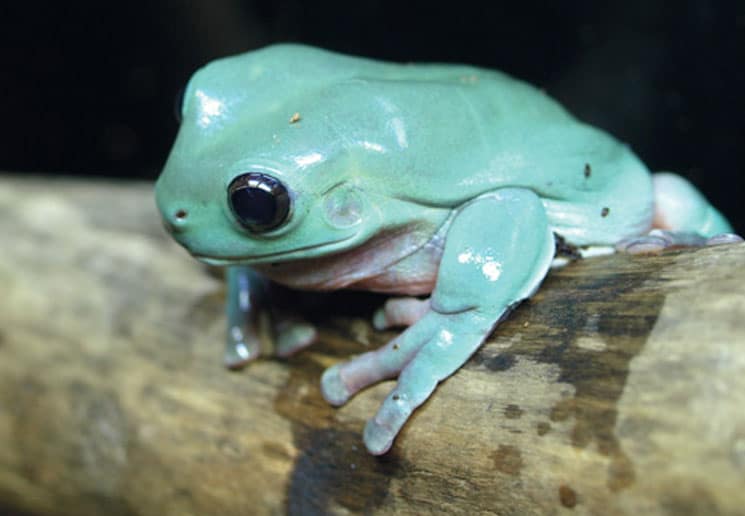Although dumpy, White’s treefrogs are also hardy, comical and popular.
Some people have compared them to Jabba the Hutt because of their greedy appetite and fat rolls. Others say their smiling faces and personable eyes are adorable. I think White’s treefrogs (Litoria caerulea) are a little of both. At times they’re so gluttonous it seems they will eat anything, but they always do it with a cute treefrog face that can charm nearly anyone. These charismatic features, coupled with the frog’s hardy nature and ease of care, have made White’s treefrogs one of the most popular pet amphibians.
Large and Lovable
The genus Litoria contains 181 frog species, and all are native to Australia and surrounding island countries. Many are arboreal and sport a typical hylid body structure: Their eyes face forward, they have sticky toe pads, and their body structure is suited for life aboveground. Some species are also semiaquatic. At first glance these appear more like ranids, which have webbed feet, powerful hind limbs, dorsolateral lines and enlarged tympanums.
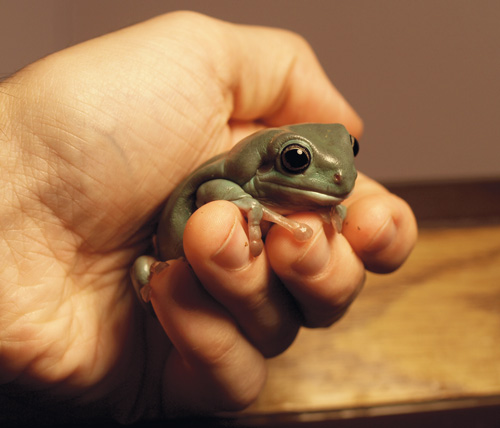
Photo by Devin Edmonds
Both beginning and experienced amphibian hobbyists can enjoy White’s treefrogs.
White’s treefrog fits the arboreal Litoria category well. Growing to nearly 4 inches long, these big frogs are also often dubbed “dumpy treefrogs” or “Australian green treefrogs” besides the more frequently used common name White’s treefrog. Typically they vary from green to brown dorsally, and some individuals appear jade or even turquoise. Tiny white spots may speckle the backs of some individuals. Like many other treefrogs, White’s treefrogs are capable of changing their color depending on environmental conditions. Light intensity, temperature and humidity levels may all play a role in the colors displayed. Two “lines” of White’s treefrogs are in the pet trade. One, blue in color, originates from Australia; the other, often exhibiting a pear to olive-green color, is from Indonesia.
Keeping White’s treefrogs in captivity is not difficult. They greedily devour all commonly available feeder insects, and their housing requirements are easy to meet. When acquired in good health, kept in the appropriate environment and fed a suitable diet, they are quite hardy. They have been documented as living more than 20 years in captivity.
The White’s Treefrog Enclosure
Although White’s treefrogs are inactive during the day, at night they make use of all the room you provide them. Adults require an enclosure no smaller than a standard 20-gallon aquarium. A 30-gallon tall aquarium works for a trio. House maturing juveniles in smaller enclosures, such as a standard 5- or 10-gallon aquarium, so they can find food easily. Good airflow is important for a frog’s long-term health, so use a screen cover to provide plenty of ventilation on any treefrog enclosure.
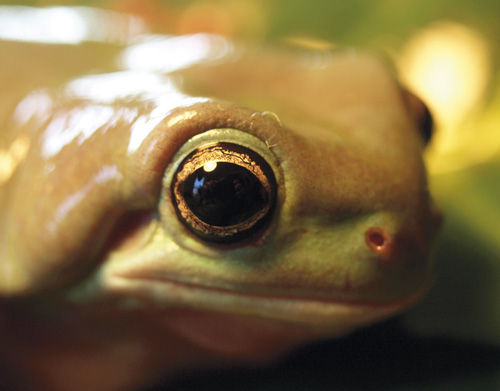
Photo by Devin Edmonds
This Australian blue White’s treefrog’s forward-facing eyes are one characteristic of hylid frogs.
Paper towels are the simplest substrate to use. Although they are not particularly pleasing to the eye, they are hygienic, practical and safe. Dampen several sheets with dechlorinated water, and then place them on the aquarium bottom. In a large enclosure with a single frog, the paper towels may only need to be replaced weekly. In smaller housing with several frogs, you’ll want to change them every day.
Two alternatives to this sterile substrate option are ground coconut-husk fiber and long-fiber sphagnum moss (not to be confused with green forest moss, which I do not recommend for these frogs). If using either one, ensure it remains moist, so it does not stick to the frogs. At the same time do not allow it to become saturated with water. Make sure to spot-clean frequently by daily removing feces, dead feeder insects or other waste. If this is done, the substrate only needs to be replaced every two to three months.
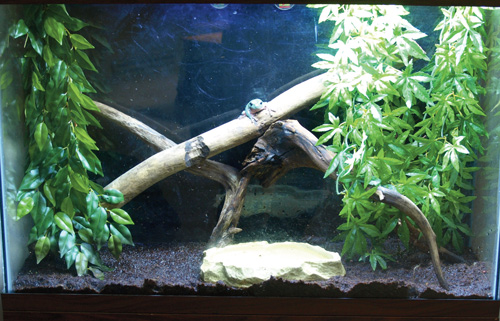
Photo by Devin Edmonds
A screen cover provides ventilation in this 37-gallon aquarium for White’s treefrogs. Artificial plants are suction-cupped to the back of the tank.
Avoid gravel or small bark chips as substrates. White’s treefrogs may accidentally swallow these while feeding, resulting in a blocked digestive tract.
Over the selected substrate, position several perches for your frog. Cork-bark slabs can be slanted against a corner in the cage, or a large cork-bark tube can be cut to size and wedged in place between the enclosure sides. Branching pieces of driftwood, bamboo poles and plastic PVC pipe segments also make great perches.
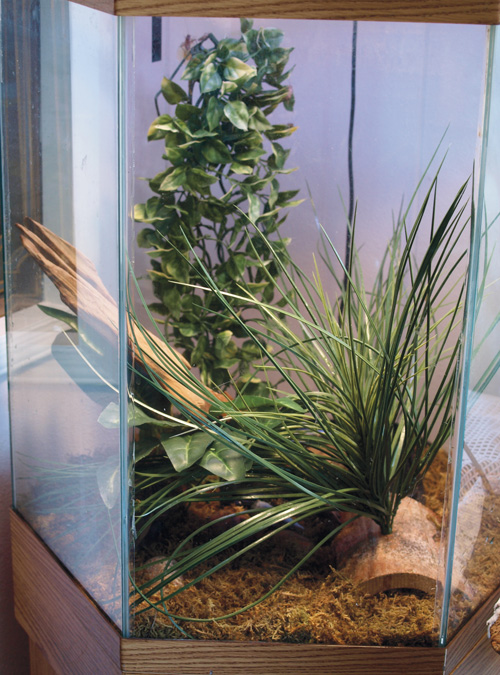
Photo by Devin Edmonds
White’s treefrogs use all the room provided in this 35-gallon aquarium with sphagnum moss substrate.
You can add a plant or two to the frogs’ housing for aesthetics and to help maintain humidity. Artificial plants can be suction-cupped to a cage side or draped over a branch. Sturdy and supportive live potted plants work equally well. Pothos (Scindapsus aureus) and Chinese evergreen (Aglaonema spp.) are two good options. Ensure plants are free of potentially harmful chemicals, such as pesticides, leaf shiners and fertilizers, by rinsing them under tap water and growing them outside of the cage for several weeks before use. Also, replant live plants in a soil safe for amphibians. An organic one free of perlite and vermiculite is recommended.
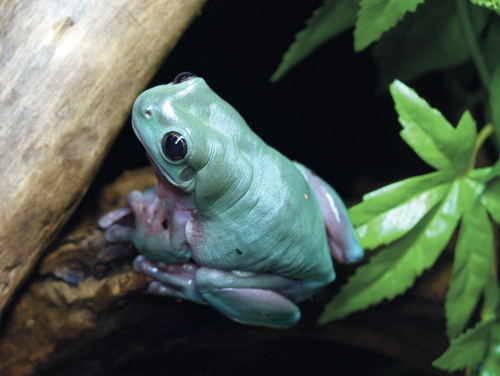
Photo by Devin Edmonds
Charismatic features have helped to make White’s treefrogs one of the most popular pet amphibians..
To complete the setup, add a large water dish for your frog to soak at night. Fill this dish with tap water treated with an aquarium water conditioner to remove chlorine, chloramines and heavy metals. Change the water daily.
Forgiving Frogs
In Australia and New Guinea White’s treefrogs experience a range of temperatures depending on the time of year, and this makes them particularly hardy captives. As long as temperature changes are gradual, they tolerate both cool and warm conditions in which more sensitive amphibians perish.
Ideally, maintain an enclosure between 75 and 85 degrees Fahrenheit during the day, and temperatures can drop 5 to 10 degrees at night. You can position a low-wattage infrared light bulb above one end of the enclosure to achieve the appropriate temperature range. Depending upon where you live, what your room temperature is, and how cold it gets in the evening, you may need to leave the bulb on 24 hours a day, or you may be able to shut it off at night. Use an accurate thermometer to measure the temperature. A digital thermometer with an external probe is a good choice.
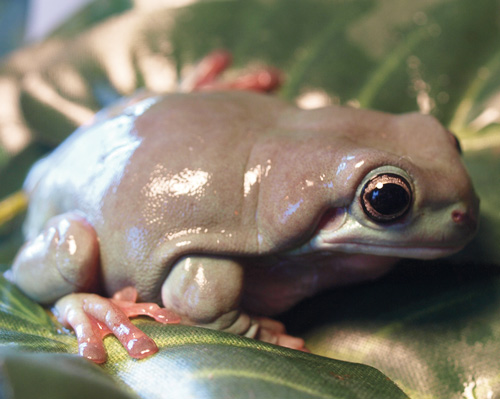
Photo by Devin Edmonds
White’s treefrogs experience a range of temperatures in their native ranges. This makes them forgiving frogs in captivity.
Other than a heat source, no additional lighting is required as long as there is indirect daylight in the room where the frogs are kept. According to some observations, however, they may develop brighter colors when kept under lighting that emits ultraviolet light, so placing an UVB-producing bulb designed for amphibians atop the screen cage cover is an option. Use an electrical timer to keep this light on for 10 to 12 hours a day.
Normal household humidity levels between 40 and 60 percent are adequate for White’s treefrogs. Not native to wet, tropical rain forests, this frog fares poorly if kept at constant high-humidity levels. Instead, mist the enclosure with water every other day to bring about temporary increases in humidity similar to what wild frogs experience after rainfall. I use distilled or reverse-osmosis water to avoid water spots on the glass. Adults can cope with dry conditions as long as a bowl of water is available for hydration. Small juveniles dehydrate easier, so consider misting their enclosures daily. Once frogs are half-grown you can mist them as you would adults.
Feeding White’s Treefrogs
I will never grow tired of watching White’s treefrogs eat. They lunge at crickets with lightning speed and comically use both hands to stuff big meals into their mouths. You can even hand-feed them, but be careful they don’t accidentally get your finger.
As entertaining as it is to watch these frogs eat, it’s important not to overfeed them. Obesity is one of the most common health problems in captive White’s treefrogs, but it’s easy to prevent. Other nutritional disorders, such as secondary hyperparathyroidism and corneal lipidosis, are also fairly common.
Readily available from pet stores, crickets can form the bulk of the diet. Increase their nutritional value by gut loading them well for at least two days before offering them to your frogs. Sliced oranges, sweet potatoes, squash, carrots, flake fish food and prepared cricket diets are all good options for bulking up feeder insects.
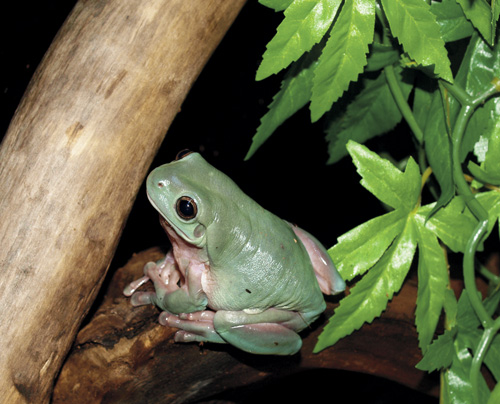
Photo by Devin Edmonds
White’s treefrogs are capable of changing their color depending on environmental conditions.
To provide dietary variation, which helps ensure all nutritional requirements are met, feed White’s treefrogs other prey every few feedings. Earthworms, cockroaches, moths, houseflies, waxworms and silkworms are great for this purpose. If you can’t find these at the local pet store, try a bait shop, herp expo or specialty feeder insect company on the Internet. Place worms and insect larvae in a dish so they don’t burrow into substrate.
In addition to invertebrates, adult White’s treefrogs also accept thawed pinky mice dangled in front of their heads. These are OK to feed no more than once a month; otherwise health problems, such as obesity, can develop.
How often you feed your treefrogs depends on both the frog’s age and how much food is offered. Juveniles can be fed daily in small quantities (one to three crickets per frog), but adults should be fed less often and in slightly larger amounts. Six crickets every three to four days per adult frog is adequate. Avoid offering food longer than the width of the head to froglets. Juveniles may eat larger food items, such as big crickets and earthworms, but it is best to avoid anything too big. Older frogs can eat pinky mice, night crawlers and other frogs.
A critical aspect of a White’s treefrog’s diet is vitamin and mineral supplementation. Two powdered supplements are needed to ensure long-term health. One should consist of calcium and vitamin D3, and the other should be a general multivitamin supplement. Frogs yet to reach adult size should have their food lightly coated in these supplements before most feedings. Adults should have their food dusted lightly in a supplement at every other feeding. For best results alternate between the calcium-vitamin-D3 and multivitamin supplements. Also make sure to replace supplements every six months because they degrade in quality once exposed to air.
Breeding White’s Treefrogs
White’s treefrogs are a great first amphibian to breed because offspring are in high demand and tadpoles are relatively hardy. However, if you pursue this endeavor, be prepared to have a lot of small feeder insects around. A pair of these treefrogs can produce hundreds of juveniles in a season.
Examine a frog’s vocal sac to determine whether it’s male or female. A male’s vocal sac appears dark and swollen if it has been calling regularly. Females call, too, but not so often or intensely. Males are also sometimes slightly smaller than females, but this is not always obvious. A surefire way to sex White’s treefrogs is to examine the forearms of a frog conditioned for breeding. Males ready for a mate have darkened nuptial pads at the base of the thumb. These appear dark brown in color and slightly rough in texture, and they are used to help hold onto the female during breeding.
Although breeding can occur with only a male-female pair of treefrogs, it’s often best to have a group. Some breeders use twice as many males as females, but this is not necessary. Start by keeping them dry and cool for a month or two. Mist once a week, depending upon the size of the cage, and maintain temperatures between 60 and 70 degrees. This conditioning tricks frogs into thinking it is winter, but remember to only expose healthy, established adults to these conditions because it can be quite stressful.
Following this simulated dry season, gradually warm the frogs up to normal daytime temps over the course of a week or two, and begin misting and feeding them daily.
At this point, males should begin calling each night. If you observe females softly calling in response, it’s time to move the frogs to a rain chamber for breeding. A rain chamber includes a pump circulating water through a tube with small holes drilled in it hanging near the top of the tank. To simulate rain, turn the pump on, so water is pushed through the tube, out the holes and down onto the frogs in little drops. Use a submersible aquarium heater to heat water to nearly 85 degrees, and provide some floating vegetation and pieces of driftwood that jut out of the water for frog perches.
White’s treefrogs lay eggs on the surface of water. If you don’t notice eggs after one week, move the frogs back to their normal housing, feed them heavily for several weeks, and try the rain chamber again.
Tadpole Care
Tadpoles break free from eggs after two to three days. Once they are active and sporadically swimming, you can move them from the rain chamber to aquaria with filtered water heated to a temperature in the low 80s.
Like adults, tadpoles are not picky eaters. They enthusiastically eat regular fish flake, which can be fed daily. Other foods, such as thawed bloodworms, can be offered instead of fish flakes twice a week. Make sure to do frequent partial water changes to maintain high-quality water.
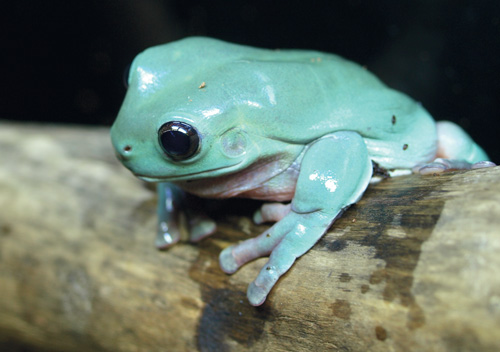
Photo by Devin Edmonds
As this Australian blue White’s treefrog demonstrates, its sticky toe pads help it live an arboreal lifestyle.
After four to six weeks, tadpoles will have developed front arms, and they will climb up the side of the aquarium to leave the water. It’s a good idea to float a few pieces of cork bark on the water at this time to help morphing tadpoles crawl out. Move emerging froglets to a separate enclosure that includes a shallow water dish, moistened paper-towel substrate and a potted plant. A standard 10-gallon aquarium is enough room for as many as 25 froglets at first, but be prepared to sort frogs by size into other enclosures over the following weeks as they grow.
Once tadpoles absorb their tails, offer one to three small crickets to them each night. Supplement the insects with vitamins and calcium at every feeding.
Something for All
White’s treefrogs are personable, hardy and easy to care for. They make perfect first frogs, but more experienced amphibian hobbyists also enjoy them. As long as these treefrogs are fed a healthy diet and provided with suitable environmental conditions, you will be able to enjoy your pets for years.
Color Codes
Size matters. Many people choose to keep White’s treefrogs in groups. This is a great way to display frogs, and it’s quite fun to watch them call and interact at night. However, because of their endless appetite and cannibalistic tendencies, ensure all frogs housed together are close to the same size.
Species matters. Never house White’s treefrogs with other amphibian or reptile species. Not only can they eat smaller frogs, but housing different species together puts all of the enclosure’s inhabitants at risk for having their care compromised due to their different habitat needs.
White’s Treefrogs in the Wild
In Australia White’s treefrogs range from New South Wales to northern Western Australia. Populations are also dispersed throughout parts of Indonesia and Papua New Guinea. They inhabit dry forests, grasslands and domestic areas, such as home gardens, cisterns or even bathrooms.
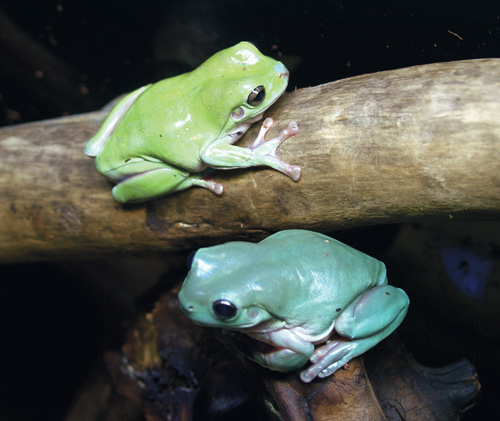
Photo by Devin Edmonds
Indonesian (top) and Australian White’s treefrogs can be found in the pet trade.
Being mostly nocturnal, White’s treefrogs become active at sunset and start hunting for food. Wild frogs eat katydids, field crickets, beetles, moths and smaller frogs, such as desert treefrogs (Litoria rubella).
During the wet season, November through February, breeding occurs in temporary pools of water. Producing a short, rough-sounding croak, males repeatedly call near these pools to attract a mate. Females deposit as many as 2,000 eggs on the water’s surface, and eggs sink to the bottom the following day.
Tadpoles develop during the next six weeks and complete metamorphosis before the austral winter arrives in June. During the driest part of winter, White’s treefrogs may create a mucous cocoon and burrow to retain moisture.
Health Check
Crucial to succeeding with any animal is starting with healthy stock. Here are three questions to ask yourself.
1. Was it captive bred? White’s treefrogs imported from Indonesia are regularly available from herp dealers and pet stores. These wild-caught amphibians are often found in poor condition, and they may succumb to bacterial or parasitic infections during acclimation. To avoid this, purchase captive-bred frogs. They typically fair better than wild-caught animals. Additionally, turquoise-blue White’s treefrogs originating from Australia are only available as captive-bred stock, so if you wish to keep this beautiful color variant, you’ll need to find a breeder or a store that offers captive-bred frogs.
2. Does it look unhealthy? Avoid White’s treefrogs showings signs of poor health. Healthy frogs are asleep during the day unless food is available or they have been disturbed. Their eyes should be clear and not clouded, and their dorsal coloration should not be patchy. However, note it is normal for some individuals to be patterned in small white dots. Examine their skin for unusual bumps. Nematodes of the genus Dracunculus often infest the skin of wild-caught frogs and cause small swellings. Look at the skin on their ventral side. It should be off-white without much redness, which may indicate advanced stages of a bacterial infection.
3. How are conditions? Inspect the White’s treefrogs’ housing conditions. If they are not suitable for temporary housing, or if other frogs in the enclosure appear unhealthy, consider another source for your treefrog.

